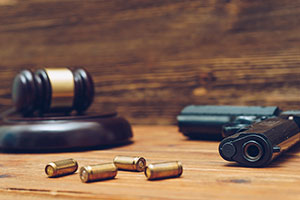A ballistics expert has offered testimony in the federal lawsuit over the fatal shooting of 17-year-old Justus Howell that happened in 2015.
The Shooting
In April 2015, Zion police officer Eric Hill responded to reports of a fight between two men and gunshots. According to authorities, Justus Howell had been trying to steal a semi-automatic pistol from a man from whom he had originally arranged to purchase it. A surveillance video shows the two men fighting, Howell pointing the gun at the other man, the man pushing the gun away, and the gun discharging.
Officer Eric Hill arrived on the scene. Hill claims that after a short chase and telling Howell to stop, he saw a flash of silver in Howell’s hand that he determined to be a gun. Hill says that he feared for his life and the lives of the other officers, so he shot Justus Howell two times.
In May 2015, Lake County State’s Attorney Michael Nerheim found that Officer Hill’s use of force was justified.
Trial Testimony
Howell’s grandmother sued Hill and the city of Zion for damages, claiming that Officer Hill acted recklessly and with excessive force when he shot her grandson. The attorney for the plaintiff argued that Hill covered up his actions after the shooting and that he “doctored” the scene. The plaintiffs argue that the gun found on Howell was in his pocket and later placed on the grass.
Attorneys for the plaintiff retained Ronald Scott as an expert witness. Scott is a forensic ballistics expert who has served 25 years with the Massachusetts State Police. Scott reviewed all of the documents related to the shooting, the surveillance video footage, and Hill’s personnel files. Scott testified that he “consider[ed] [Hill] to be an above-average trained police officer.”
Scott testified that the forensic evidence and the surveillance video show that Howell was nearly doubled over when he was shot by Hill. This would be inconsistent with Hill’s statement that he fired at Howell after he had turned a gun on him.
Scott also testified that he was able to determine Hill’s approximate position during the shooting by analyzing the shell casings that were found at the scene and Howell’s autopsy. Scott testified that Hill shot Howell and the bullets entered his body diagonally from the left to the right.
Scott also noted that the surveillance video did not show a reflection of a gun or light-colored object in Howell’s hand. The gun that was found at the scene had a silver finish.
Defense attorney Thomas DiCianni questioned Scott’s credibility and testimony. DiCianni cited to a deposition whether lawyers hired him to “bust a hole” in Hill’s testimony. Scott replied that his responsibility is to the evidence. DiCianni cited a forensics handbook on police shootings that said that shell casings were unreliable evidence. DiCianni also pointed out the the gun found at the scene had a matte finish, so would not have flashed in the video footage.
Verdict
The jury evidently rejected the expert testimony. It returned a verdict in favor of the defense, finding that the evidence failed to establish that Hill used excessive force.




